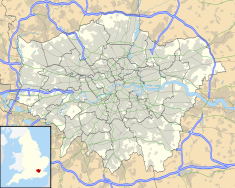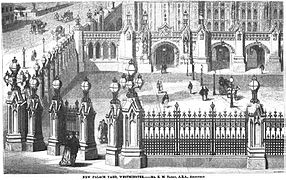
The Palace of Westminster is the meeting place of the Parliament of the United Kingdom and is located in London, England. It is commonly called the Houses of Parliament after the House of Commons and the House of Lords, the two legislative chambers which occupy the building. The palace is the centre of political life in the United Kingdom; "Westminster" has become a metonym for the UK Parliament and the British Government, and the Westminster system of government commemorates the name of the palace. The clock bell in the Elizabeth Tower of the palace, nicknamed Big Ben, is a landmark of London and the United Kingdom in general. The Palace of Westminster has been a Grade I listed building since 1970 and part of a UNESCO World Heritage Site since 1987.

Scotland Yard is the headquarters of the Metropolitan Police, the territorial police force responsible for policing Greater London's 32 boroughs. Its name derives from the location of the original Metropolitan Police headquarters at 4 Whitehall Place, which had its main public entrance on the Westminster street called Great Scotland Yard. The Scotland Yard entrance became the public entrance, and over time "Scotland Yard" came to be used not only as the common name of the headquarters building, but also as a metonym for the Metropolitan Police Service (MPS) itself and police officers, especially detectives, who serve in it. The New York Times wrote in 1964 that, just as Wall Street gave its name to New York's financial district, Scotland Yard became the name for police activity in London.
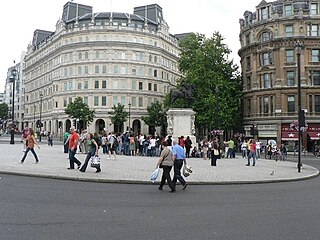
Charing Cross is a junction in Westminster, London, England, where six routes meet. Since the early 19th century, Charing Cross has been the notional "centre of London" and became the point from which distances from London are measured. Clockwise from north, the routes that meet at Charing Cross are: the east side of Trafalgar Square leading to St Martin's Place and then Charing Cross Road; the Strand leading to the City; Northumberland Avenue leading to the Thames Embankment; Whitehall leading to Parliament Square; The Mall leading to Admiralty Arch and Buckingham Palace; and two short roads leading to Pall Mall.

Trafalgar Square is a public square in the City of Westminster, Central London, established in the early 19th century around the area formerly known as Charing Cross. The square's name commemorates the Battle of Trafalgar, the British naval victory in the Napoleonic Wars over France and Spain that took place on 21st October 1805 off the coast of Cape Trafalgar.
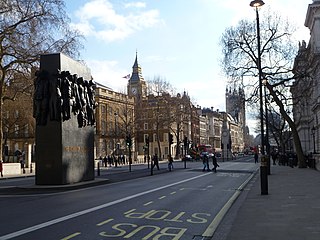
Whitehall is a road and area in the City of Westminster, Central London, England. The road forms the first part of the A3212 road from Trafalgar Square to Chelsea. It is the main thoroughfare running south from Trafalgar Square towards Parliament Square. The street is recognised as the centre of the Government of the United Kingdom and is lined with numerous departments and ministries, including the Ministry of Defence, Horse Guards and the Cabinet Office. Consequently, the name "Whitehall" is used as a metonym for the British civil service and government, and as the geographic name for the surrounding area.

The Strand is a major street in the City of Westminster, Central London. The street, which is part of London's West End theatreland, runs just over 3⁄4 mile (1.2 km) from Trafalgar Square eastwards to Temple Bar, where it becomes Fleet Street in the City of London, and is part of the A4, a main road running west from inner London.
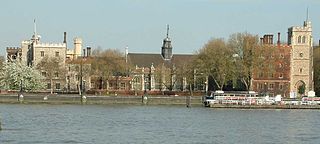
Lambeth Palace is the official London residence of the Archbishop of Canterbury. It is situated in north Lambeth, London, on the south bank of the River Thames, 400 yards south-east of the Palace of Westminster, which houses Parliament, on the opposite bank.

Victoria station, also known as London Victoria, is a central London railway terminus and connected London Underground station in Victoria, in the City of Westminster, managed by Network Rail. Named after the nearby Victoria Street, the main line station is a terminus of the Brighton Main Line to Gatwick Airport and Brighton and the Chatham Main Line to Ramsgate and Dover via Chatham. From the main lines, trains can connect to the Catford Loop Line, the Dartford Loop Line, and the Oxted line to East Grinstead and Uckfield. Southern operates most commuter and regional services to south London, Sussex and parts of east Surrey, while Southeastern operates trains to south-east London and Kent, alongside limited services operated by Thameslink. Gatwick Express trains run direct to Gatwick. The Underground station is on the Circle and District lines between Sloane Square and St James's Park stations, and on the Victoria line between Pimlico and Green Park stations. The area around the station is an important interchange for other forms of transport: a local bus station is in the forecourt and Victoria Coach Station is nearby.

Westminster is a London Underground station in the City of Westminster. It is served by the Circle, District and Jubilee lines. On the Circle and District lines, the station is between St James's Park and Embankment, and on the Jubilee line it is between Green Park and Waterloo. It is in Travelcard Zone 1. The station is located at the corner of Bridge Street and Victoria Embankment and is close to the Houses of Parliament, Westminster Abbey, Parliament Square, Whitehall, Westminster Bridge, and the London Eye. Also close by are Downing Street, the Cenotaph, Westminster Millennium Pier, the Treasury, the Foreign and Commonwealth Office, and the Supreme Court.

Westminster Bridge is a road-and-foot-traffic bridge over the River Thames in London, linking Westminster on the west side and Lambeth on the east side.

St Thomas' Hospital is a large NHS teaching hospital in Central London, England. Administratively part of the Guy's and St Thomas' NHS Foundation Trust, together with Guy's Hospital, Evelina London Children's Hospital, Royal Brompton Hospital and other sites. It is also a member of King's Health Partners, an academic health science centre, and is one of three sites used by King's College London GKT School of Medical Education.

St James's Park is a 23-hectare (57-acre) urban park in the City of Westminster, central London. A Royal Park, it is at the southernmost end of the St James's area, which was named after a once isolated medieval hospital dedicated to St James the Less, now the site of St James's Palace. The area was initially enclosed for a deer park near the Palace of Whitehall for King Henry VIII in the 1530's. It is the most easterly of a near-continuous chain of public parks that includes Green Park, Hyde Park, and Kensington Gardens.

Parliament Square is a square at the northwest end of the Palace of Westminster in the City of Westminster in central London, England. Laid out in the 19th century, it features a large open green area in the centre with trees to its west, and it contains twelve statues of statesmen and other notable individuals.

This article covers the history of London from the Norman conquest of England in 1066 to the death of Richard III in 1485. During this period, London became the capital of England, as monarchs held Parliament at the Palace of Westminster, beginning in 1265 and increasing over the 14th century. London appointed its first recorded Lord Mayor in this period, Henry FitzAilwin, in 1189. In the 12th century, the writer William Fitzstephen described it as florilegium urbanum — "flower of cities".

The Stuart period in London began with the reign of James VI and I in 1603 and ended with the death of Queen Anne in 1714. London grew massively in population during this period, from about 200,000 in 1600 to over 575,000 by 1700, and in physical size, sprawling outside its city walls to encompass previously outlying districts such as Shoreditch, Clerkenwell, and Westminster. The city suffered several large periods of devastation, including the English Civil War and the Great Fire of London, but new areas were built from scratch in what had previously been countryside, such as Covent Garden, Bloomsbury, and St. James's, and the City was rebuilt after the Fire by architects such as Christopher Wren.
The following is a timeline of the history of London, the capital of England and the United Kingdom.

On 22 March 2017, a terrorist attack took place outside the Palace of Westminster in London, seat of the British Parliament. Khalid Masood, a 52-year-old Briton, drove a car into pedestrians on the pavement along the south side of Westminster Bridge and Bridge Street, injuring more than 50 people, four of them fatally. He then crashed the car into the perimeter fence of the palace grounds and ran into New Palace Yard, where he fatally stabbed an unarmed police officer. He was then shot by an armed police officer, and died at the scene.

On 14 August 2018, three people were injured when a silver Ford Fiesta hit them near the Palace of Westminster, London, England. The car then went on to crash into the separation barrier of the pavement situated between St Margaret Street / Abingdon Street and Old Palace Yard. The Metropolitan Police responded within seconds and arrested the driver, Salih Khater, without further incident. An ambulance immediately behind the Ford stopped and gave assistance to the injured. Khater was subsequently found guilty of two counts of attempted murder and sentenced to life in prison.

